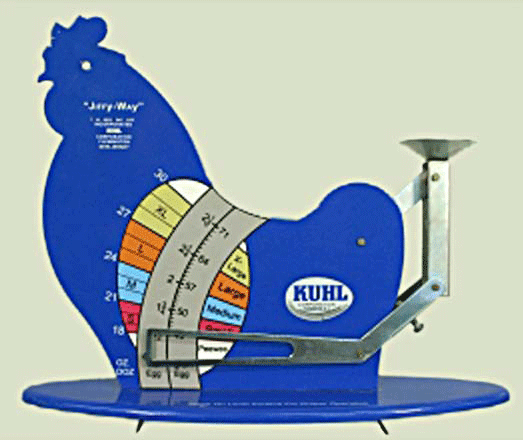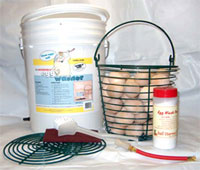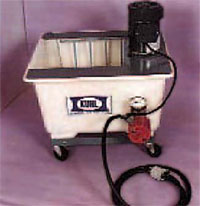



Small-Scale Egg Handling - 2
This is a continuation of last week's feature on the production and sale of eggs for small-scale and free-range egg producers published as Small Scale Egg Handling by ATTRA, the US National Sustainable Agriculture Information Service.Methods for washing, candling and grading
The capacity of washing methods is often described in terms of cases. A case is 30 dozen or 360 eggs and a half case is 15 dozen.
Manual methods
Washing
Methods that use spraying, pouring or dipping reduce the time of contact between water and egg. As mentioned earlier, soaking eggs is generally not recommended because it may allow microbes to enter the shell.
If you have just a few eggs, use a brush and wash them in a sink with hot running water and then dip them in a sanitizer (Bigbee and Froning, 1997). The water should be warmer than the egg. Prewetting and using a detergent will help. Brushes that can be sanitized are helpful. For example, surgical brushes, which are small nylon brushes packed with micro bristles, are made to clean hands and under nails and are useful in egg cleaning because they can easily be sanitized in the dishwasher or bleach water.
Dip washing
To wash several dozen eggs, make up separate basins of detergent, rinse water and sanitizer solutions. Wash each egg separately and do not soak. Dip the egg in rinse water, and then dip it in sanitizer. Using an egg basket or colander to rinse and sanitize many eggs at once will save time. Set eggs aside to dry. It is important to remember to change the detergent and rinse water after every 3 to 4 dozen eggs. Use gloves to protect hands from hot water, detergent and sanitizer (Bigbee and Froning, 1997). Sinks with three basins are ideal for this method and can usually be found through bar and restaurant equipment suppliers. Also available through similar sources are brushes atop a suction base that will attach to the bottom of the sink and can be used under wash water, freeing up a hand in the scrubbing process. Be cautious of disposing wash water on the farm because the detergents and sanitizers may be highly caustic or chlorinated and your septic will suffer if fed the mix (Davis, 2005).
Spray or pour washing
Robert Plamondon, a small-scale producer in Oregon, provides the following recommendation:
While the eggs are in wire baskets or plastic egg crates, shower them generously with the use of a watering can with 100 degrees water that contains detergent and enough chlorine to bring the level to 100- 200 ppm. Allow the wash water to run away from the eggs by sitting the basket atop a drain. After standing a few minutes the eggs may need to be watered again. Then wipe the eggs individually with a paper towel. Replace the paper towel often during the process. A cloth towel should not be used because it may continue to be used long after it has become dirty. Clean eggs should then be placed in a clean wire basket or plastic fl at. Clean eggs are then sanitized by generously showering them with 100 degree water that is 100-200 ppm chlorine. You can dry the eggs manually or let them air dry. Drying racks can be made with halfinch hardware cloth on a wooden frame. The eggs will also dry if put into the refrigerator while still in the basket or crates. Wet eggs should not be placed in cartons because they will stick (Plamondon,2001).
Candling
For hand candling, there are many different setups.

[Photo courtesy Maine Organic Farmers and Gardeners.]
According to Colorado State Extension, “a suitable light can be handmade by cutting a 1.25-inch diameter hole in the end of a coffee can. Insert a light bulb fi xture through the lid, using a 40-watt bulb. View the interior of the egg by holding the large end up to the hole cut in the bottom of the can. As the light passes through the egg, twirl the egg several times. If blood spots are present, you will see them” (Geiger, 1995). Another lowtech way to candle is by taping a 3-inch length of empty bath tissue paper tube to a flashlight. Suppliers such as Nasco, Kuhl and Rochester Hatchery offer hand candlers.
Grading
For small-scale grading, gravity operated scales can be found for less than $70. They are available through Kuhl, Nasco, Rochester Hatchery and other suppliers.
The small egg scales that most catalogues sell are not very accurate and are not for legal trade. If you do a lot of wholesaling, you need to get a commercial scale that will be inspected regularly for accuracy. A diet or kitchen scale is usually enough for people who sell small numbers directly to the consumer.

Photo courtesy of Meyer Hatchery.
Mechanical egg washing and grading
Machinery may be needed if the amount of eggs being processed is too much to do by hand. Although immersion washing is not recommended, there are some machines on the market. Check with your state egg laws to see if immersion washing is allowed. Oregon egg producer Robert Plamondon recommends only cleaning 3 dozen eggs per gallon of water in the machine before replacing the water and using the proper amount of chlorine or sanitizer. Prewetting is also helpful.
Immersion washers

[Photo courtesy of The Incredible Egg Washer Co.]

[Photo by Mike Geubert.]
The Incredible Egg Washer is a plastic bucket that handles 8 dozen eggs at a time. It includes a 10-inch egg basket and is small enough to use in a kitchen. An air compressor bubbles water around the eggs. It costs about $100 but the air compressor is sold separately and costs about $140. It is offered by The Incredible Egg Washer Co., Nasco, and other suppliers.
Producer Mike Geubert described how to make a similar system on the farm. This can save on costs, especially if one already owns an air compressor. The bubbler system can be made with PVC piping with holes drilled throughout the base and an air coupler to connect to the compressor. The regulator on the compressor can be used to adjust the pressure to 10 to 5 pounds per square inch. The system is made to fi t in a 5-gallon bucket, which also holds an 8- dozen-size egg basket. Eggs are given a 5- 7 minute bubbling warm water, about 100 degrees, bath before a rinse in warm water. Eggs that are still dirty may need a quick wipe and another rinse before being set to dry (Guebert, 2007).
The Kleen Egg Turbo Air-Wash, available through Rochester Hatchery, is a 7-gallon galvanized bucket with a heating element and egg basket. It washes from 10 to 15 dozen eggs in 3 to 5 minutes and has an adjustable thermostat to maintain water temperature. It costs about $400 but also requires an air compressor to blow air bubbles through the water. According to producer Robert Plamondon, “with a suitably small compressor, this would work fi ne in the kitchen”(Plamondon, 2000). The heating element is an 115-volt, 1,500-watt element. You can fi ll it with hot water from the kitchen sink and it is small enough to pick up and dump used water. In fact, for kitchen use Plamondon does not recommend plugging in the heating element because “by the time the water’s cold, it’s probably also dirty”(Plamondon, 2000). In this case it would probably only be necessary in a situation where one did not have access to hot water.

Kuhl Corp. offers a large fi berglass immersion egg washer that cleans from one to eight cases, or 360 to 2,880 eggs, in an hour and operates with an egg crate or egg basket. It is large enough that it cannot be lifted to dump water out and requires a fl oor drain. These KF Models are offered for 110- volt or 220-volt electricity and both cost more than $1,200.
Dishwasher
Dishwashers are used experimentally for washing eggs by some small egg producers. Dishwashers are used with a detergent suitable for egg washing and not dishwasher soap because it is too harsh. Dishwashers may be able to clean eggs with the sheer force of the water. Only the top rack should be used, as the bottom rack is too close to the jets and will cause the eggs to bounce around and break. The main things that should be considered are achieving proper water temperature and drainage.
Dishwashers usually heat the water hot enough to potentially cook the eggs. This could be resolved by setting the water heater to from 110 to 120 degrees and turning off the dishwasher’s heat dry or temperature sensor feature so that it doesn’t heat the water and the eggs more than what is necessary.
Drainage issues result from the soil and feathers that are washed off the eggs building up in pipes and eventually creating clogs. The fi lter on the dishwasher is usually large enough to let debris pass. Even though clogs may not be a problem in the beginning, some producers discover a clogged line after several months, especially if there is a large percentage of very dirty eggs. A separate water outlet pipe for an egg-washing dishwasher may be appropriate.
Chlorine can be added to the water during the rinse cycle to sanitize the eggs, but it may be time-consuming to wait for the change in cycles. If the eggs are not extremely dirty just using the rinse cycle may be suffi cient.
Brush and spray washers
Brushing and spraying is an ideal way to clean eggs. However, there are only a few small brush and spray washing machines currently on the market and most eggwashing equipment is very large and runs hundreds of cases each hour for large-scale production. Large-scale egg washers use water sprays and brushes to clean eggs and can process 500 cases an hour. Brushes are usually oriented perpendicular to egg flow. The spinning of eggs around their vertical axis facilitates cleaning. Wash water is re-circulated in large machines and new replacement water is added to maintain a continuous overflow.

Kuhl Corp. offers the EBEW 1-5, which processes from one to five cases an hour, or from 360 to 1,800 eggs. A recycled spray is used to clean eggs. Eggs are rotated on rubber rollers during cleaning and then pass through a sanitizing spray. A grader or farm packer can be attached.
The Nat ional Poult ry Equipment Company offers the Sani-Touch line of machines, which come in models 5, 10 and 20, referring to the number of cases that can be processed in an hour. These machines are washer and sanitizer units with driers that have optional candling and grading attachments. The machines require water and drain hookups but come with their own water heater. The Sani-Touch models do not recycle the water. The Model 10 is more than 13 feet long and 2 feet wide, and the Model 5 is more than 10 feet long without candler or grader additions.
An additional attachment is a spool-spinner candler that rolls the eggs around for viewing and even has a mirror on the back so you can see both ends of the eggs. It can be combined with a vacuum-operated egg lifter to load six eggs at a time on the candler section. The grader bolts onto the far end of the unit and separates the eggs into six grades, peewee through jumbo.
In the past Sani-Touch units were sold under the AquaMagic name and have been made for decades. It may be possible to find used equipment and parts are still available that work with the old machines.
Producer Robert Plamondon describes his used Aquamagic:
“The AquaMagic candles, washes (with a water spray and brushes), dries (with fans and more brushes). The washer section works MUCH better than immersion washers, and the drier section means you don’t have to leave eggs sitting around to dry. The washer comes with a little pump that pumps detergent/sanitizer solution out of a bucket and mixes it with the warm wash water. It comes with a chute loader, which is a ramp that you fi ll up with a row of eggs. They roll slowly down the ramp as the washer picks the eggs up one at a time. The washed/sanitized/dried eggs come out the far end onto a table, where you pick them up and put them into fl ats or cartons. For a little extra, you can have a candling light added onto the chute loader, where a bright light shines up through a slot in the chute, allowing you to candle the eggs as they pass by.” (Plamondon, 2000)
The smaller Model 5 sanitizer unit with candler costs from $10,500 to $11,000 (or slightly less without the candler) and $26,500 with the candler and grader. Two people can run it at 75 percent of its top speed. The larger Model 10 S costs about $14,000 with a candler (slightly less without the candler) and $29,000 with the spool-spinner candler and grader. It requires four people — a loader, candler and two packers — to run it at top speed.
The water heater that comes with the Sani-Touch models is very intricate. It may be possible to connect it up to an existing source of hot water for some savings. The machines are sturdy and can process over 2,000 dozen eggs a day (Plamondon, 2003).
Candlers and graders
National Poultry Equipment sells a freestanding grader, the Sani-Touch Model CG.
The Egomatic was a candler and grader that was sold in the past in the United States and is sometimes sold as used equipment.
Oiling
Eggs can be oiled with a food-grade mineral oil after washing to help reduce moisture or CO2 loss, maintain the internal quality of the egg and prevent the introduction of microbes. In the United States eggs are generally distributed quickly and oiling is not necessary. Oiling is more important in warmer areas where there is a risk of inadequate refrigeration (Hutchison et al., 2003).
The third part of this publication will be published on ThePoultrySite next week.
Further Reading
| - | You can view Part 1 of this publication by clicking here. |








